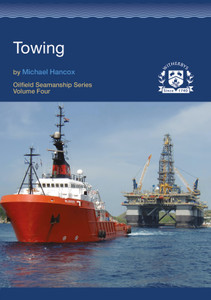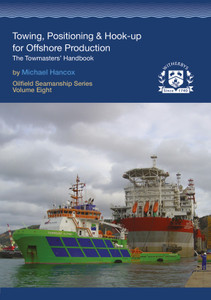
This publication discusses the planning, organisation and execution of the movement of semi-submersible vessels and barges. It describes operations from the barge viewpoint and contains data on towing vessel selection, conduct of towing operations and contingency planning. It also covers loading of semi-submersible cargo carriers, modular transport operations and other specialist work. Previously published by Clarkson Research Services Ltd.
This book describes and illustrates the preparations required before moving barges and semi-submersibles. It discusses the planning stage, the role of the Warranty Surveyor, use of towing gear, contingency planning, sea fastenings and dry transport. It is a detailed and practical manual of standard operating practices, but may also be used as a planning tool by shore-based staff.
The Oilfield Seamanship series describes and explains standard techniques used in marine operations in offshore oilfields. The series concentrates on towing, anchor handling, barge mooring and moving, the operation of jack-up vessels afloat, the practice of stability control on semi-submersibles and ballast control techniques.
In the context of this book, barge moving deals with the preparations, organisation and procedures used during the movement of semi-submersible vessels and flat barges from one location to another.
In the sections dealing with semi-submersible vessels the types envisaged are principally drilling and accommodation support vessels. This is because these vessels spend long periods of time stationary, anchored in position and then undertake a passage whose duration may be a few hours or many days. The transition from stationary operations to transit operations requires the crews to make quite radical changes to behaviour and routine patterns as well as putting into operation procedures and plans which differ considerably from their normal stationary life. The majority of operations covered are those where some tug assistance is utilised although this may be supplemented by the vessel’s own propulsion systems.
In the majority of cases the semi-submersible will be manned and its Master will direct and oversee the activities of the tug or tugs involved. In this role they (the tugs) follow the courses and navigate as directed by the tow and are to some extent acting in the role of harbour tugs towing a vessel under the direction of a pilot.
The command structure of semi-submersible vessels often follows a somewhat unusual pattern. In North Europe and the USA semi-submersible drilling units (especially those with propulsion systems) are usually under the command of a Master who holds a formal qualification and it is this individual who directs the operation (moving and mooring). He may be assisted by a Tow Master or Rig Mover who may be an employee of the vessel’s owner or charterer.
On non-propelled semi-submersibles and some specialist type units (pipelay barges and derrick barges are good examples) the person in charge of the vessel may have a variety of titles, Barge Superintendent, Toolpusher, etc, and he may not actually direct operations but delegate this function to another individual, Tow Master, Barge Engineer or Tower Foreman.
The title Offshore Installation Manager (OIM) has found wide acceptance in the offshore oilfields and refers to the individual on a vessel or a fixed structure (production platform) who is in overall charge of the safety of the unit and its personnel. He may have statutory duties and obligations laid upon him by both Port State and Flag State regimes and stands in a similar position as that of Master.
Depending on the owner’s policy and local rules the OIM may not have any formal marine qualifications although with respect to a very large proportion of the vessels under consideration the individual will hold some certification and many will hold Class 1 Master’s Certificates.
The other type of vessel dealt with in this section is that commonly referred to as a flat barge. In the offshore oilfield such vessels may have specialist functions, for example, trench barges, derrick barges, launch barges, semi-submersible cargo carriers, pulling barges, flat topped cargo barges and drilling tenders. These vessels all share certain common characteristics. They are generally flat bottomed, flat topped and without propulsion of any kind. They can be extremely large, often up to 190 metres in length, 50 metres beam and 7 metres draft and capable of carrying very large weights up to 30,000 tonnes.
In the context of this book these barges are classed for ocean going service and may be fitted with quite elaborate ballast and power systems. They are towed from place to place by both oceangoing tugs and oilfield tugs (AHT and AHTS Class vessels). Generally these cargo carrying barges are unmanned, however prior to departure from port, especially if loaded with high value or special cargoes, a representative of the owners will attend to oversee ballasting and checking of the power plants and other systems.
Part
1.
Introduction
–
Scope
and
Purpose
Part
2.
Planning
the
Move
Part
3.
Duties
of
Warranty
Surveyors
Part
4.
Semi-submersible
Moving
Operations
Part
5.
Preparation
of
Cargo
Barge
Part
6.
Contingency
Planning
Part
7.
Sea
Fastenings
Part
8.
Dry
Transport
Witherby Publishing Group
Witherbys titles are developed using scripts developed by technical experts that are peer reviewed within work groups. Typically, they seek to improve understanding of the regulations, recommendations and guidelines issued by Industry.
Witherbys staff have significant expertise in the fields of navigation and hazardous cargoes as well as in the presentation of complex subjects in a graphic and easy to understand manner.
- Number of Pages:
- 495
- ISBN:
- 9781870945714
- Published Date:
- April 1995
- Binding Format:
- Paperback
- Book Height:
- 300 mm
- Book Width:
- 210 mm
- Weight:
- 1.2 kg
- Author:
Michael Hancox
- Preview:
- Yes
- Physical:
- (Out of Stock)
 Witherbys.com
Witherbys.com





